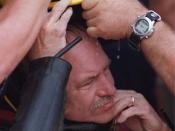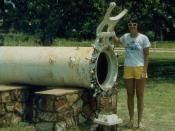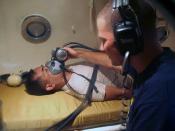Following a deep dive in water, humans can experience severe pains upon returning to the surface too quickly, and the resulting
body injury may cause unconsciousness and death. Aches are so severe in some cases, commonly in the joints, that divers
bend over in agony. Hence, the name, the bends. However, the more common name for this condition is decompression
sickness, meaning that the sickness results from decreasing pressure.
Divers experience decreasing pressure upon ascent to the surface of the water. This is expected because pressure gradually
increases with increasing depth of the water. Increases in pressure with depth are a result of increasing weight of the water. For
example, at 150 feet, because of this weight, pressures on all surfaces of the body are four and one-half times greater than they
are at the surface. At this depth, pressure on the diver's chest cavity, lungs, and air within the lungs causes gases such as
nitrogen in that air to dissolve in the blood of lung tissue.
Dissolved nitrogen at high pressure and deep water causes no
problems as long as the diver does not ascend. When the diver ascends, pressure decreases (decompression), and nitrogen is
released from the blood into body tissues as bubbles. This process is similar to the appearance of bubbles in a soda after the
cap is removed. Bubbles appear because the pressure that kept them dissolved was removed with release of the cap. These
nitrogen bubbles in tissues are the factor which cause damage, sickness, and death. However, some mammals do not
experience decompression sickness. These are the whales, porpoises, and dolphins, known collectively as cetaceans.
Cetaceans do not experience complications during dives as humans do, even though nitrogen dissolves in the blood of
cetaceans to the depth of 200 feet. Beyond that level, cetacean...


